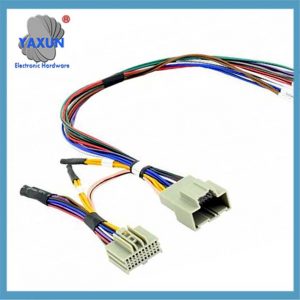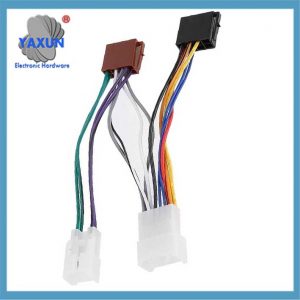Analysis of car audio wiring system
I. Power supply line
BAT wire
Color identification: usually yellow or red16.
Function: directly connected to the positive pole of the battery to provide continuous power supply (even if the engine is turned off, it remains powered)67.
Requirement: It needs to be protected by a fuse, and the wire diameter is thicker to ensure stable current7.
 PAC APH-FD02 Speaker Harness B&O Amp System for Ford F-150 250 350 550 |
 Radio Wiring Harness Adapter for Selected Chevrolet, GMC, Buick, Car Radio Stereo Wire Harness |
 Car Audio ISO Wiring Harness, for Connection Line Car Radio Stereo Install |
ACC control line
Color identification: red16.
Function: controlled by the car key, powered on after the key is started, and powered off when turned off67.
Application: Control the on/off logic of the audio host to avoid power consumption after the engine is turned off7.
Start line (KL15)
Function: used for memory function or anti-theft system in some models, and needs to be connected to the 12V positive pole37.
II. Grounding line
Ground wire (GND)
Color identification: black16.
Connection method: It needs to be reliably connected to the metal frame of the vehicle body or the negative pole of the battery to ensure a low impedance circuit 12.
Note: The contact points need to be polished clean to avoid oxidation causing poor contact or noise 37.
CAN bus grounding (CANGND)
Function: Together with CAN+, it forms an on-board communication network, and no additional wiring is required 23.
Note: Some audio systems interact with the vehicle through the CAN protocol, and the original vehicle line must be retained during modification 34.
III. Signal line
Audio signal line
Composition: It includes four sets of speaker lines (front/rear, left/right channels), and the positive and negative poles must be distinguished 16.
Anti-interference: It is recommended to use shielded wires and keep them away from power lines to avoid crosstalk 8.
Control signal line
LIN line: It is used for steering wheel button control (such as volume adjustment), and no changes are required 23.
SCON line: It controls the automatic shutdown function and needs to be connected to a 12V power supply to achieve delayed power off 37.
Reversing image signal line: The video input line needs to be triggered synchronously with the reversing light power supply (connected to the positive pole of the reversing light)1.
Additional function line
USB/GPS antenna: It needs to be wired separately, usually extending to the storage box or inside the A-pillar to avoid damage14.
Backlight line (ILL): Connect the +12V power supply to light up the panel lights3.
Key points Wiring sequence: Connect the ground wire first, then the power line and signal line in turn to avoid short circuit risks17.
Wire selection: Use high-quality copper core wire, the power line must meet the current load, and the signal line is recommended to be double-shielded78.
Anti-interference processing: The power line and signal line are routed separately and kept vertical when crossing8.
Long-distance signal transmission requires the installation of filter capacitors or magnetic rings78.
Interface protection: All exposed joints need to be wrapped with heat shrink tubing or special tape to prevent oxidation and loosening13.
By properly planning the power supply, grounding and signal lines, the stability and sound quality of the audio system can be significantly improved while reducing the risk of modification.
Different from the wiring harness layout of other functions, car audio wiring has its own higher requirements. The wiring harness engineer in this article will take you to understand the basic knowledge of car audio wiring.
Since cars will generate interference of various frequencies while driving, which will adversely affect the listening environment of the car audio system, higher requirements are put forward for the installation and wiring of the car audio system.
1. Power cord wiring:
The current capacity value of the selected power cord should be equal to or greater than the value of the fuse connected to the power amplifier.
If sub-standard wires are used as power cords, AC noise will be generated and the sound quality will be seriously damaged. The power cord may become hot and burn.
When using a single power cord to separately power multiple amplifiers, the length of the wiring from the point of separation to each amplifier should be as equal as possible. When the power lines are bridged, a potential difference will appear between each power amplifier. This potential difference will cause AC noise, seriously damaging the sound quality. The picture below shows the car light wiring harness, heater, etc.
When the host is powered directly from the mains, noise is reduced and sound quality is improved. Thoroughly remove any dirt from the battery connectors and tighten the connectors tightly.
If the power connector is dirty or not tightened, there will be poor contact at the connector. The presence of blocking resistors will cause AC noise, seriously damaging the sound quality. Use sandpaper and a fine scraper to remove dirt from the joints, and apply butter at the same time. When routing wiring within a vehicle’s powertrain, avoid routing it near the generator and ignition, as generator noise and ignition noise can radiate into the power lines.
When replacing the factory-installed spark plugs and spark plug cables with high-performance types, the ignition spark will be stronger and ignition noise will be more likely to occur. The principles followed for laying out power cables and audio cables inside the car are the same.
2. Grounding method:
Use fine sandpaper to remove the paint from the grounding point of the car body and secure the grounding wire tightly. If car paint remains between the car body and the ground terminal, it will cause contact resistance at the ground point. Similar to the dirty battery connectors mentioned above, contact resistance can lead to the generation of AC noise, which can seriously damage the sound quality. Concentrate the grounding of all audio equipment in the audio system at one point. If they are not grounded at one point, the potential difference between the components of the audio system will cause noise.
3. Selection of car audio wiring:
The smaller the resistance of the car audio wire, the less power is consumed on the wire, and the higher the efficiency of the system. Even if the wire is thick, a certain amount of power will be lost due to the speaker itself, without making the entire system 100% efficient.
The smaller the resistance of the wire, the greater the damping coefficient; the greater the damping coefficient, the greater the unnecessary vibration of the speaker. The larger (thicker) the cross-sectional area of the wire, the smaller the resistance, the larger the allowable current value of the wire, and the greater the allowable output power. When choosing a power fuse, the closer the fuse box of the main power cord is to the car battery connector, the better. The insurance value can be determined according to the following formula: insurance value = (sum of the total rated power of each power amplifier in the system ¡ 2) / average car power supply voltage.
4. Audio signal cable wiring:
Use insulating tape or heat shrink tubing to wrap the audio signal cable joints tightly to ensure insulation. When the joint comes into contact with the car body, noise can be generated. Keep audio signal lines as short as possible. The longer the audio signal line is, the more likely it is to be interfered by various frequency signals in the car. Note: If the length of the audio signal cable cannot be shortened, the extra long part should be folded instead of rolled up.
The audio signal cable should be routed at least 20cm away from the trip computer module circuit and the power cable of the amplifier. If the wiring is too close, the audio signal lines will pick up frequency interference noise. It is best to route the audio signal cables and power cables separately on both sides of the driver’s seat and passenger’s seat. Note that when wiring close to power lines and microcomputer circuits, the audio signal lines must be at least 20cm away from them. If audio signal cables and power cables need to cross each other, we recommend that they intersect at 90 degrees.
 English
English العربية
العربية Български
Български Čeština
Čeština Dansk
Dansk Nederlands
Nederlands Suomi
Suomi Français
Français Deutsch
Deutsch Magyar
Magyar Italiano
Italiano 日本語
日本語 한국어
한국어 Português
Português Română
Română Русский
Русский Slovenščina
Slovenščina Español
Español Svenska
Svenska Tiếng Việt
Tiếng Việt
